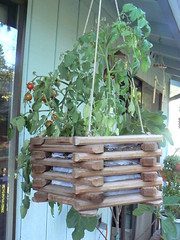
These are a variety called Tumbler, available from Totally Tomatoes. It's a determinate hybrid bred for compact growth, so it does well in containers. I also grow full-size tomatoes in the ground, including several heirloom varieties. The full-size tomatoes have been slow to ripen, especially since the weather has turned cool these last two weeks. I should have some any day now, but in the meantime I can raid the hanging baskets for my homegrown tomato fix.
Because tomatoes are so popular with gardeners, there's lots of lore related to growing them. Every tomato grower has his or her favorite varieties and tips for success. Mine are below. But keep in mind: What works in one area may not work in another, due to differences in climate, soil, pests, etc. And, what works for one gardener may not work for another. Experiment, find what works, and tell other gardeners about it! You can start by leaving me a comment--I'm always looking for ways to do things better.
Janet's tomato tips
Soil and mulch: I grow my tomatoes in clay soil amended with compost. In addition, I mulch my tomato plot with about 6" of leaves every fall after removing the dead vines. These break down over the winter, adding organic matter to the soil while suppressing early spring weeds and keeping the soil from being compacted by our winter rain. When it's time to plant tomatoes (on or after Mother's Day here in Portland), I rake the remaining mulch back from about a 1' circle, in the center of which goes a tomato seedling. I add more mulch, usually straw, to the pathways between rows to suppress weeds and hold in moisture.
Fertilizer: While I try to garden organically most of the time, I'm not a purist. I use time-release chemical fertilizer for my tomatoes, usually Miracle-Gro. About a half teaspoon per plant does the trick.
Eggshells: After planting my seedlings, I surround each one with about a 4" circle of eggshells, which we save throughout the winter and spring. They serve two purposes. First, they keep slugs away. Apparently the sharp shells are uncomfortable for the evil little mollusks to cross. Second, as they break down, they add calcium to the soil throughout the growing season. The calcium helps prevent blossom end rot, a common problem with certain types of tomatoes, especially Roma. Since I started using eggshells a few years ago, I've had only one tomato with blossom end rot, and it was a mild case. Before the eggshells, about half my Romas would be affected, along with plenty of other varieties too.
Water: Tomatoes, like most plants, do best with deep, infrequent watering. My amended clay soil holds moisture well, so I can usually get away with watering once or twice a week unless it's really hot.
Please leave your tomato-growing tips as comments, so we can all learn from each other.


1 comment:
Janet-
This year I put down balck plastic to raise the soil temp of my tomato beds early, and lifted it before planting. I had my tomatoes in the ground on Apr. 23, after amending the soil with liberal amounts of compost and digging a few generous handfuls of complete organic fertilizer (from Steve Solomon's recipe.) The tomatoes were protected from frost with Wall O Waters for several weeks. I watered the tomatoes once or twice early in the season, but I haven't watered since then. Since the plants were in the ground so early, they had a chance to develop a really deep root system before the soil started drying out for the summer.
This season I grew Siberia, Rutgers, San Marzano, Black Krim (which I'd purchased at New Seasons last year and saved the seed from!), Stupice and Jelly Bean.
The Siberia were an experiment (had them in the ground in Wall O Waters on April 2, but the WOW's cooked the plants, kind of like sticking an Inuit in a sauna for a few weeks. They eventually recovered but I was disappointed that they didn't begin to ripen any earlier than the others, and most of the fruit are golf ball sized, not my favorite for eating and too small to deal with for canning.
Everything else is doing marvelously!! Yum. Do you have any favorite recipes to share?
Post a Comment